Response to the Home Affairs Committee Inquiry Into Asylum Applications
22 April, 2003
Summary1. Contrary to popular belief, there has been no major increase in the worldwide total of asylum seekers nor in the number coming to Europe over the last ten years. However, the proportion of applicants to Europe who come to Britain has increased enormously from 5% in 1992 to 27% in 2002.
2. Clearly, Britain is perceived as the destination of preference. "Pull" factors include a free and prosperous society, the presence of immigrant communities, and an international language. But to these must be added political reluctance to address the issues, lack of policy grip and serious administrative weakness.
3. The result is a system that is highly unsatisfactory both to genuine asylum seekers who face a system clogged with false claimants and to the electorate of whom 85% believe that the Government have lost control of asylum and immigration; 80% wish to see much tougher immigration control.
4. The Nationality, Immigration and Asylum Act 2002 is inadequate - if not irrelevant. Only root and branch reform of the legal framework can restore public confidence and avoid a serious threat to community relations.
Reasons for the rise in asylum applications in the UK
over the last 10 years
5.The underlying reasons for asylum seeking, and for migration
more generally, continue to be oppressive regimes, wars, internal
strife and poverty. It may be thought that adverse changes in these
factors have contributed to the rise in asylum applications in the
U.K. But, this is not the case. The number of asylum applications
worldwide in the years 1999, 2000 and 2001 were 581,000, 570,000
and 614,000 respectively - very close to the 10 year average of
594,000[1]. The actual worldwide
and EU figures for the period 1992 to 2001 are shown in the following
graph[2]:
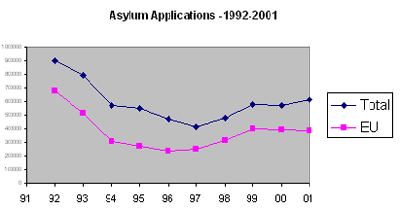
6.However, the percentage of asylum applications to Europe being
submitted in the U.K. has been rising rapidly as the following graph
shows[3] .
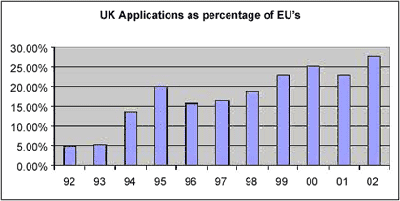
7.Britain is clearly increasingly attractive by comparison with
many other EU countries. We believe that key administrative factors
are:
|
• |
The very low removal rates of those refused asylum. |
| • | The cumbersome asylum system with its multiple appeals procedures and long delays. |
| • | The semi-automatic granting of exceptional leave to remain (ELR) to applicants from certain countries. |
| • | The ease of access to illegal work in the UK and the absence of internal controls, notably the absence of identification checks. |
| • | The relatively liberal way in which the UN Convention on Refugees (UNCR) and the European Convention on Human Rights (ECHR) have been incorporated into British law and interpreted by the judiciary. |
These factors, which reinforce each other, are explained below.
8.In the period 1998-2002 inclusive 375,850 initial decisions were made on asylum applications. During this period 143,572 applicants (38%) were granted asylum or ELR, either initially or on appeal. But only 43,330 applicants (11.5%) were removed from the country[4] . Most of those refused probably stayed in the country illegally. Thus, if you apply for asylum in the UK you have a roughly 88.5% chance of remaining in the country. Clearly this makes the UK a very attractive destination for economic migrants entering the country as asylum seekers.
9.Some progress has been made over the last two years in speeding up the decision making process but it is still slow. The average time to an initial decision came down from 35 months in 1999 to 13 months in 2001. The present objective is to make an initial decision within 2 months but only 75% of cases in Q3 2002 were made in this timescale. (Compare this with the Netherlands were 60% of decisions are made in 2 days). Over 75% of people initially refused asylum or ELR went on to appeal but only 43% of the appeals received in 2001/2 were determined within 17 weeks. (About three quarters of appeals are rejected). This had fallen to 39% in the period April to September 2002.
10.The timescales for making decisions are critical. Long timescales allow asylum seekers to get established in the UK - e.g. to find employment in the black economy, to make contacts in the ethnic communities and maybe even to find another route to staying in the UK, such as marriage. They also make it far more difficult to manage the system and to keep tabs on the large numbers involved.
11.The Home Secretary recognised in 2002 that the granting of ELR
was " no longer exceptional" and from April, 2003 ELR
will be replaced with a new category of 'humanitarian protection'.
The routine granting of ELR in the latter half of the 1990's to
asylum applicants from some major source countries meant that the
vast majority were granted either asylum or ELR at their first application.
This led to a very sharp increase in the number of asylum applications.
The following graphs demonstrate this point.
| Percentage
of applications accepted or granted ELR |
No. of applications |
IRAQ |
|
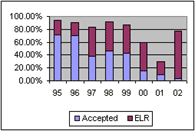 |
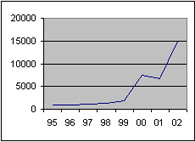 |
| AFGANISTAN | |
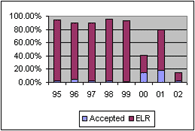 |
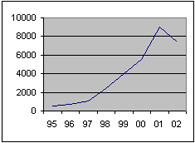 |
| SOMALIA | |
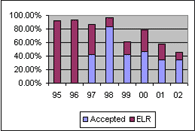 |
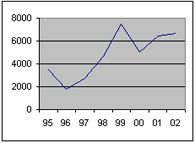 |
12.Access to work in the UK is relatively easy. Unemployment rates are low by European standards and the UK has a thriving black economy - we have seen estimates that the black economy in London is as high as 20% of the official economy. The UK has no ID cards so there is, in practice, no obstacle to accessing State services, such as healthcare and education. This adds further to the attractiveness of the UK.
13.A further attraction is the way the UNCR and ECHR have been incorporated into UK law and have then been interpreted by the judiciary. A prime example is that many European countries do not recognise persecution by non-State bodies as we do. In Britain, for example, grants of asylum may be made to Afghans on the basis that they are still at risk from the Taliban (or, indeed, vice versa), or to Jamaican homosexuals on the basis of homophobic attitudes in Jamaican society, or to Roma on the basis of racial hostility towards them by sectors of the population in parts of Eastern Europe.
How adequately and fairly are asylum applications managed today? How did the backlog of asylum determinations arise? Is it being dealt with satisfactorily?
14. From the viewpoint of the genuine asylum seeker the asylum
system is still not being managed adequately or fairly. They need
a system that processes their claims quickly, helps them to start
a new life and welcomes them into their new community. The present
situation is clogged with a large number of false claimants who
are engendering public hostility.
15. Furthermore a system which is costing £1.8 billion[5]
per year and which is failing to repatriate thousands of failed
asylum seekers is clearly one which brings the law into disrepute
and is totally unsatisfactory to the vast majority of the UK population.
This has been borne out by MORI's poll on behalf of Migration Watch[6]
which found that 85% of the population thought that the Government
had failed to get asylum or immigration under control. The same
poll found that 80% wanted much tighter immigration controls, including
52% of ethnic minority communities.
16. The scale and incidence of the asylum backlog problem can be
seen from the following graph[7]
:
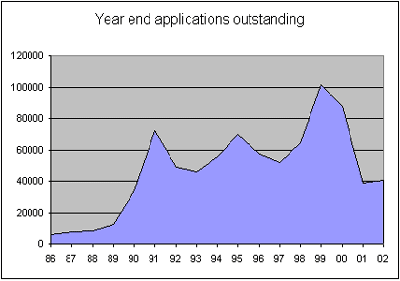
17. This backlog arose for a number of reasons:
| - | the previous government introduced a computer system (and reduced staff) but the system failed just as applicant numbers started to increase. | |
| - | the present government applied the Human Rights Act to this field, thus generating still further opportunities for delay. | |
| - | virtually automatic granting of Exceptional Leave to Remain (ELR) to certain countries (para. 11 above) contributed to massive increase in applications from those countries. | |
| - | there was a political and administrative failure to address the problems of removal. Most obviously, a huge effort was made to increase the number of initial decisions from 24,000 in 1999 to 102,000 in 2000 and 126,000 in 2001 but the number of removals rose only to about 9,000 from 7,500 in 1999. | |
| - | the appeals machinery was rapidly overwhelmed. The number of appeals received by the Appeals Support Section was as follows: |
|
1998 |
1999 |
2000 |
2001 |
2002 |
|
14,000 |
6,600 |
46,200 |
74,400 |
49,500 |
18. In evidence to the Home Affairs Committee on 4 March, the Director General of Immigration and Nationality Directorate (IND) said that the backlog had been reduced, but only by 1,000, in 2002.
How appropriately is detention used in respect of asylum applicants?
19.Detention of asylum seekers is currently rarely used in the UK. At the end of 2002 there were only 795 asylum seekers held in detention. We have proposed that asylum seekers who are found without documents (often because they have destroyed them) should be held in detention initially until their identities have been established and a security check made. We believe that this would deter asylum seekers from destroying documents and this would make this approach manageable. Furthermore, those who have been refused asylum after completing the appeals process should also be detained pending removal from the UK.
What will be the effects on the management of asylum applications
of changes made in the Nationality, Immigration and Asylum Act 2002
and the Prime Minister's pledge to halve the number of asylum seekers
by September 2003?
20. This Act was framed before the public were aware of the scale
of the problem and before there was any political will to take effective
measures. The Act was addressed mainly towards speeding up the decision
process but, unless this is accompanied by an effective removals
mechanism, such efforts are pointless. There are doubts about the
effectiveness of three of the main areas covered:
a) Refusal of benefits to in-country claimants
It is the government`s contention that asylum seekers are not well
informed about the benefits available in different countries and,
consequently, that benefits are not a significant pull factor. If
this is correct, refusal of benefits will reduce the number of claims
entering the statistics but not the number of people entering the
country. It is noteworthy that a similar measure introduced in 1996
reduced the number of in-country asylum claims by 50% over 6 months
(until it was reversed by the courts). In-country claims now account
for 65% of the total number of claims.
b) Accommodation Centres
About 3,000 places are planned. At present rates of arrival of 2,000
a week they will be full in ten days. Applicants wait at least 2
months for an initial decision and a further 4 months for an appeal
(75% of those refused appeal). Applicants are free to disappear
if they receive, or anticipate, a negative decision. In the absence
of an effective removal mechanism, it is hard to justify the cost
of construction of these centres and the disruption to local communities.
c) Restriction of Rights of Appeal
These measures are also likely to be challenged in the courts. If
they survive they will be helpful in shortening the process but,
again, effectiveness depends on enhanced removal. We are spending,
literally, hundreds of millions of pounds every year on a legal
process that has little practical effect.
21. It appears that the Home Office have interpreted the Prime Minister's pledge as a pledge to halve the number of asylum seekers from the record level of 8,900 which occurred in October, 2002. This would result in an annual figure for principal applicants of 53,400 - a reduction of less than 39% on the level for 2002 as a whole.
22. We have doubts as to whether even this figure is attainable. The October 2002 figure was particularly high because benefits were about to be restricted to asylum seekers who claimed asylum as soon as practical after entering the UK. Despite this change, asylum claims in both Nov. and Dec. 2002 increased over Nov. and Dec. 2001 by 29% for the 2 months combined.
23. Finally, we believe that an effective asylum system must be
based on:
- deterrence
- prevention
- and removal
We do not believe that this can be achieved in the present framework
of national and international law. Our view, therefore, is that
the whole legal framework is in urgent need of fundamental review.
The objective should be to introduce a system where the decision
as to how many people should be given refuge in the UK, and the
conditions under which they remain in the country, should be firmly
under the control of our national Parliament.
Footnotes
| [1] | Source Governments,UNHCR. Compiled by UNHCR (Population Data Unit). |
| [2] | Source Governments,UNHCR. Compiled by UNHCR (Population Data Unit). |
| [3] | Source Governments,UNHCR. Compiled by UNHCR (Population Data Unit). 2002 figures taken from Asylum Statistics:4th Quarter 2002 table 16 adjusted to make allowance for Italy - assuming Italy applications in 2002 equal 2001 levels. |
| [4] | From Home Office Asylum Statistics. All figures are for primary applicants. It is recognised that the figures relate to people at different stages in the asylum process so the percentages are not precise. Nevertheless they provide a reasonably accurate indication of the problems relating to removals. |
| [5] | Home Office Press Release 058/2003 |
| [6] | MORI poll conducted by Migration Watch between January 16 and January 21, 2003. |
| [7] | Source: Home Office Statistical Bulletins Asylum Statistics (various years) |
